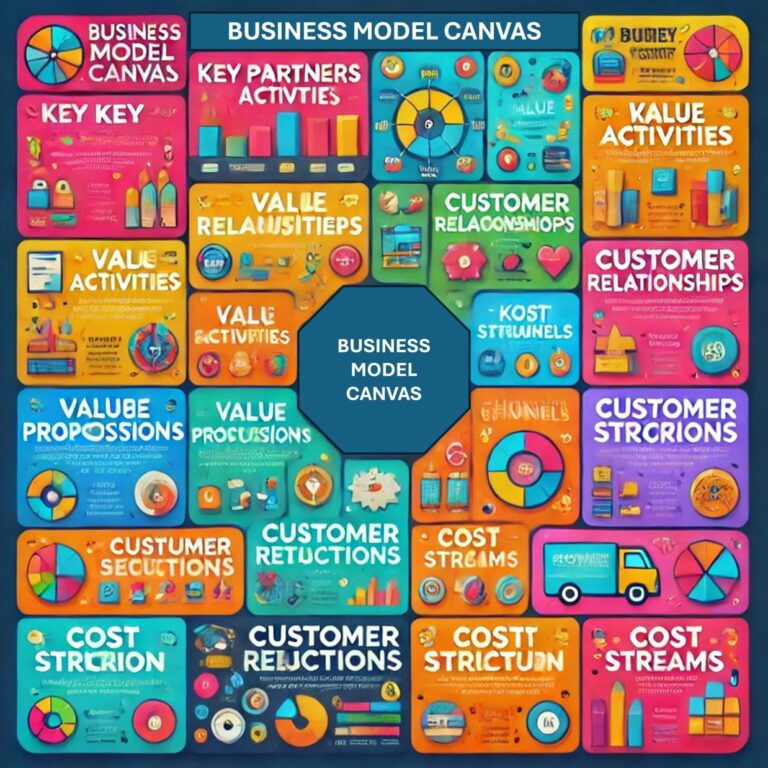9 Blocks of Business Model Canvas Explained: A Strategic Innovation Tool

How would you respond if I informed you that I earned approximately $12,000 through the Business Model Canvas (BMC) concept?
I am certain you would be curious to learn how this was achieved. Therefore, allow me to share the story behind this income. It is important to note that the entire $12,000 was not solely a result of the model; rather, it was my 24 years of experience that played a crucial role during an interview with a client. I explained to them how this model could be applied and the advantages it could offer to their business. However, the reality is that despite securing the contract, the model proved too challenging for the founders to implement fully. In this blog, we will delve into the fundamental components of the BMC and discuss how you can reap its benefits if you are able to implement it effectively. Let us begin.
In today’s fast-paced and competitive business world, innovation is not just a buzzword; it’s a necessity. This is one of my favourite quotes by me “If You’re not Innovating You are Deteriorating”. Companies that innovate tend to thrive, while those that don’t may struggle to stay relevant. But how does a company ensure that it’s continuously innovating, and how can innovation be integrated into the very fabric of a business? The Business Model Canvas (BMC) provides a practical tool for this purpose, offering a framework that encourages strategic thinking while fostering innovation. In this blog, we’ll dive into what the Business Model Canvas is, how it works, and explore its vital connection to innovation.
LOOKING FOR A TRAINING PROGRAM ON THIS SUBJECT OF BUSINESS MODEL CANVAS?
DEALS THAT YOU CANNOT MISS THIS SEASON
What is the Business Model Canvas?
The Business Model Canvas was created by Alexander Osterwalder and Yves Pigneur as a tool for entrepreneurs and organizations to outline and adjust their business models efficiently and visually, on a page, without the complexity of traditional lengthy business plans.
At its core, the canvas is divided into nine key building blocks that together provide a holistic view of any business:
- Key Partners: The external organizations, suppliers, or stakeholders who help your business succeed.
- Key Activities: The crucial actions your company must take to operate successfully.
- Key Resources: The critical assets you need to deliver your value proposition.
- Value Propositions: The unique offerings that differentiate your business and bring value to your customers.
- Customer Relationships: The types of relationships you establish with your customer segments.
- Channels: How you communicate and deliver your value proposition to customers.
- Customer Segments: The different groups of people or organizations your business aims to serve.
- Cost Structure: The major costs associated with operating your business.
- Revenue Streams: How your company makes money from its value propositions.
This canvas can be applied to any business—large or small, new or established—and is a powerful tool for startups in particular, as it provides a clear snapshot of how a business is structured, operates, and generates revenue.
The Linkage Between the Business Model Canvas and Innovation
The Business Model Canvas serves as a tool, on its own but truly excels when leveraged for fostering innovation beyond just creating new products or technologies. Its, about enhancing value creation methods and refining customer experiences and operational processes while guiding businesses to infuse innovation across all facets of their operations.
Lets dive into how each of the nine elements of the Business Model Canvas connects with innovation.
LOOKING FOR A TRAINING PROGRAM ON THIS SUBJECT
DEALS THAT YOU CANNOT MISS THIS SEASON
- Key Partners and Innovation
In todays world of business development and growth strategies are changing rapidly and companies rarely work on innovative projects alone anymore instead they often work closely with external partners such, as suppliers technology providers or even competitors to drive new ideas and advancements By pinpoint the essential collaborators on the map organizations have the chance to discover fresh avenues, for creating value Whether through collaborations strategic partnerships or subcontracted services unique collaborations hold the potential to tap into additional resources skills and knowledge that a company may lack internally
- Key Activities and Innovation
Innovation frequently prompts companies to reconsider their operations. What tasks could benefit from automation or optimization. What could potentially be outsourced?. Exploring product ranges or services is also crucial, in this context as it helps businesses pinpoint avenues for enhancing operations efficiency and cutting costs or even venturing into novel business domains. A prime example of this is how technology driven enterprises stay ahead by transitioning from methods, to digital and automated solutions.
- Key Resources and Innovation
Innovation frequently starts by utilizing resources in ways; be it, through assets such, as promoting innovation driven by employees or through the utilization of physical and technological resources. Businesses must explore ways to harness their assets to nurture creativity effectively. For instance investing in research and development often leads companies to discover solutions in their operations or product portfolios.
- Value Propositions and Innovation
This Innovation lies at the core of business success. It’s, about finding ways to distinguish yourself in the market space through your value proposition strategy! This could involve introducing product lines to the market scene; reimagining offerings; or revolutionizing how you address customer needs and challenges creatively. For instance; opting for subscription based services; promoting eco products;. Customizing experiences are all prime examples of innovative value propositions that have reshaped conventional industry norms.
Businesses should always be considering this question. How do we improve our service to meet the needs of our customers and what value could we bring that sets us apart, from the competition?
- Customer Segments and Innovation
Recognizing and catering to customer groups is essential, for business expansion and development.Innovation in this context may involve focusing on customer segments reaching out to underserved markets. Devisi supplementary strategies to engage your current clientele.Noteworthy companies such, as Airbnb and Uber have thrived by identifying gaps in their customer demographics and devising business approaches to meet the needs of these customers.
- Customer Relationships and Innovation
Businesses are always finding ways to connect with their customers as time goes by and trends change rapidly in this realm of interactions, with customers companies may introduce marketing methods or improve customer service through technology as well as create online platforms where customers can connect with one another and share experiences together like Netflix using data analysis to suggest content or social media platforms providing engaging experiences, for users are examples of how businesses innovate in forming and nurturing customer connections.
- Channels and Innovation
Innovating channels involves discovering approaches to engage customers effectively amidst the growing presence of e commerce platforms and social media networks that offer businesses avenues to interact with their target market successfully Companies must constantly seek new methods to deliver their offerings through innovations such, as novel sales outlets digital enhancements and comprehensive multi channel approaches Amazon for example has revolutionized the retail landscape by introducing inventive distribution methods and enhancing customer communication mediums
- Cost Structure and Innovation
Innovation isn’t just focused on boosting profits but, on cutting costs at times. By improving processes efficiency and embracing automation or enhancing manufacturing methods effectively businesses can lower expenses without compromising quality. This might entail transitioning to cloud based solutions reducing dependence, on infrastructure or implementing methodologies to minimize waste and enhance value.
- Revenue Streams and Innovation
One of the areas of innovation is the way companies generate revenue streams by introducing new methods to earn money from their products and services such, as subscriptions and freemium models as well as usage based pricing and crowdfunding which have significantly changed traditional sectors, like Netflix which shifted from renting DVDs to offering a subscription based streaming service thereby revolutionizing its operations.
Using the Business Model Canvas to Drive Innovation
The Business Model Canvas isn’t a piece of paper that stays the same forever; it should be seen as a resource that evolves over time for companies to drive innovation forward actively. By reviewing and enhancing the canvas content regularly enables businesses to identify chances, for innovation. Such, as introducing products or services or expanding into different markets. Or refining their internal processes effectively.
Here are a few tips for using the BMC to drive innovation:
- Lets collaborate, with teams to come up with ideas! Get people, from departments together to think about aspects of the project canvas because innovation thrives when different disciplines intersect.
- Try out ideas. Keep refining them by using the canvas to get feedback, from customers swiftly.
- Remain adaptable. The platform is crafted to offer flexibility allowing you to adjust your business strategy in accordance, with shifts, in the market landscape.
- Ensure that customer feedback is incorporated into the innovation process as it plays a role, in driving business advancements that cater to customer requirements through the Business Model Canvas alignment.
My Conclusion
The Business Model Canvas plays a role, for entrepreneurs and businesses aiming to foster innovation efforts effectively. By evaluating each aspect of the business model with a perspective in mind organizations can keep pace with competition deliver value to customers and adjust to the dynamic business environment. Whether you’re a venture striving to enter the market or a standing company endeavoring to stay current the Business Model Canvas provides a straightforward route, to sustainable innovation.
I hope this blog provides you with a base to grasp how the Business Model Canvas can drive innovation in any business, as a reader!. Feel free to drop a comment if you need any adjustments made.

Syed Saif has over two decades of experience in Quality, Excellence, Innovation, Six Sigma, Lean, and Customer Services. He is a Certified Master Black Belt, ISO Lead Auditor, High Impact Trainer, Certified Business Excellence Assessor, Certified on Innovation Business Model Canvas, and holds a PG diploma in Customer Relationship Management. Syed Saif has trained thousands of people, from students to CEOs on various improvement methodologies and self help techniques, and has worked in various industries including BPO, Telecom, IT, Insurance, Manufacturing, and Healthcare. Prior to his full-time consulting role, he served as Vice President for a Leading Insurance Company and as National Head of Quality, Innovation, and Service for Corporate and Sales Functions. See our services page for more details on what we do and how can we help you / your organization.